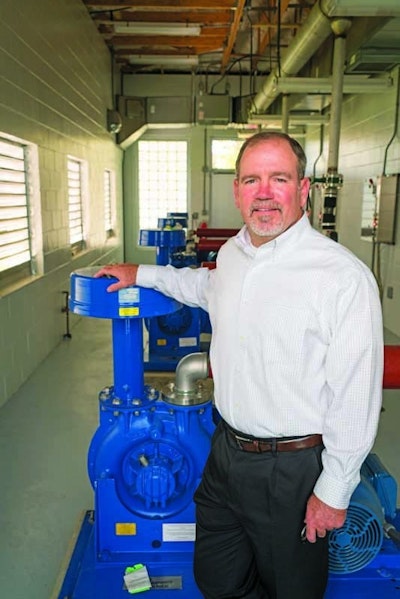
Interested in Stormwater?
Get Stormwater articles, news and videos right in your inbox! Sign up now.
Stormwater + Get AlertsRacking up state and national awards is almost second nature for the City of Tallahassee (Florida) Stormwater Management Group. The accolades recognize one of the state’s most robust stormwater utilities that is often responsible for innovative firsts, driven by a $9.2 million capital improvement program.
The climb to the top of that hill was steep and winding. The group formed in 1987 as a result of the losing hand dealt by topography and weather. Tallahassee ranks ninth-rainiest in the nation and second-rainiest in the state. Rolling hills, clay soils, and elevation changes of up to 200 feet exacerbate runoff. Some neighborhoods built before stormwater and land development regulations were enacted are in flood-prone areas.
“Those factors created huge challenges, and we needed ways to address them,” says Jodie Cahoon, P.E., and manager of Stormwater Management. “We created the first stormwater utility in the state and pioneered the equivalent residential unit concept.”
Today, 86,000 residential and 8,500 nonresidential customers pay a monthly $7.95/ERU stormwater fee.
From the onset, the department focused much of its energy and money on alleviating flooding. To date, the city has spent in excess of $125 million on 150 citywide stormwater projects that have protected more than 750 properties. Multiple regional stormwater facilities have changed the city’s landscape and become community amenities.
Stormwater and erosion control projects also garnered a long list of awards, including four from the Big Bend Branch of the American Public Works Association since 2010. The 2014 Excellence Award from the Florida Stormwater Association recognized the multifaceted stormwater program’s successes over 25 years. In 2015, the Underground Utilities Department, which includes SMG, won the Governor’s Sterling Award for its organizational performance and management excellence.
“The Sterling Award is Florida’s highest honor for an entity,” says Cahoon. “We’re the first public utility in the state to receive it.” The city now joins the ranks of honorees such as Merrill Lynch, AT&T, Honeywell, the Ritz Carlton Hotels, Boeing Special Operations Forces Aerospace, and Lockheed Martin.
Small budgets, big returns
The city’s most cost-effective method of treating stormwater pollution is to stop it before it enters waterways. An annual $1.9 million street-sweeping budget captures 2,600 tons of debris at the source. The award-winning Think About Personal Pollution campaign demonstrated that load reductions from education efforts saved $450,000 annually versus spending an additional $2.5 million per year on traditional best management practices.
“While these programs have minor expenditures, they are very important to our overall success,” says Cahoon. “Working with citizens is the best approach to stopping pollution before it happens.”
To that end, Cahoon visits the city’s two universities four times a year to lecture on stormwater management and planning. A large part of one campus and its parking lots are in low-lying areas. Signs warn students to park at their own risk during heavy rains. “Once they understand the topography, they realize these areas will always be prone to flooding,” says Cahoon.
The city’s annual nine-week Neighborhood Leadership Academy has been another valuable outreach effort. The workshops provide homeowner associations and community leaders with a thorough understanding of government operations, the appropriate approach to bring change to their neighborhoods, and the best ways to access city programs and services.
“Educating citizens about the stormwater program enables them to help us more effectively, and for us to serve the community more efficiently,” Cahoon says. The city even branded the Utilities Department as “Your Own Utilities.”
Under the department’s umbrella, SMG includes the Planning and Administration Division, which administers regulatory compliance, floodplain management, the Stormwater On-Site Mitigation Loan Program, and lakes monitoring. The Pollution Reduction Section coordinates public education and outreach. Public Works Operations sweeps streets and maintains 425 stormwater management ponds, 24 miles of major outfall canals, 25,000 concrete drainage structures such as manholes and inlets, 430 miles of drainage pipes, 60 miles of drainage ditches, and 370 miles of roadside and outfall ditches spread over 103 square miles. The group includes 95 scientists, biologists, engineers, planners, administrators and maintenance personnel.
Ounce of prevention
Because homes are a primary financial investment, the SMG floodplain management program participates in the Federal Emergency Management Agency Community Rating System. By providing discounts on flood insurance, the system encourages communities to undertake activities beyond those required by the National Flood Insurance Program.
As part of these activities, SMG sends every property owner in the city’s floodplain an annual letter reminding them that they are eligible for flood insurance. “Properties change hands and awareness is key,” says Cahoon. “Insurance is an excellent tool to minimize losses.”
Besides notifying residents, SMG accurately maps floodplains using ArcGIS software (Esri). Building codes specify structures in floodplains must be built 2 feet above the flood elevation. “We build multimillion-dollar capital projects in areas with repetitive flood losses to help citizens, which also reduces claims to the federal government,” Cahoon says. “For all these activities, FEMA rewarded residents with a 20 percent discount on flood insurance premiums.”
Two staffers administer the Stormwater On-Site Mitigation Loan Program, the only one in the state. “Government can’t fix all problems, so we began this program to help people help themselves,” Cahoon says. The program is restricted to owner-occupied homes. Grants are available for low-income customers.
Under the public relations umbrella, SMG provides low-interest financing, enabling homeowners to make on-site improvements to prevent or reduce flooding. Using stormwater utility funds, the city provides a loan or grant to hire an engineer and contractor for improvement projects. Loan repayments are included in the customer’s utility bill. Since 2000, more than 112 customers have received over $300,000 in financial aid.
Flood relief
Protecting neighborhoods from flooding and erosion requires moving from small fixes to full-scale capital improvements — the keystone of the stormwater program and recipient of most of the stormwater utility fees. Although the city hires consulting firms and contractors for these projects, SMG has seven project managers (professional engineers and scientists) who follow each undertaking from inception to completion.
Nobody knows a community better than its residents. “Our project managers work closely with neighborhoods to determine which observations are perceived and which are realities,” Cahoon says. “The engineers collaborate with consulting engineers, then they discuss solution alternatives with the community during the design phase.” Three in-house construction inspectors, one per project, oversee contractors’ work to ensure they meet the city’s expectations.
One project involved a 129-acre residential community bisected by an eroded clay-lined control channel. “More than 40 properties flooded, and residents occasionally had to be evacuated by boat,” Cahoon says. The canal, conveying runoff from a 3,400-acre urban watershed, produced velocities of more than 10 feet per second. A roadway adjacent to the canal was threatened by flooding and undermining.
To alleviate the problems, the contractor stabilized 1,530 feet of canal with gabion baskets and reno mattresses (Maccaferri Group) and underlined them with woven geotextile material (TenCate Geotube). Workers also used steel sheet piling to stabilize an additional 1,520 feet of channel.
“In gabion baskets, voids between the stone help capture sediment, which promotes vegetative growth and phytoplankton to enhance biological uptake,” Cahoon says.
“Detention time is excellent because the canal bottom remains wet. It mimics a rock media trickling filter in a wastewater treatment plant.”
The $6.27 million project also included a large secondary drainage system retrofit, and relocating more than 800 feet of utility lines and a 42-inch sewer. It won the 2012 Top Stormwater and Erosion Control Project from Storm Water Solutions, a national magazine.
“The depth of competition is deep,” Cahoon says. “Judges select the top 10 stormwater projects in the country based on unique site constraints, obstacles overcome, and goals achieved. While the size and breadth of most projects represent substantial capital investments, the most significant factor is what that money accomplished.”
Homes dry and safe
A prime example of what stormwater fees accomplish is the $2.46 million Eastgate subdivision project, in which up to 30 properties experienced hazardous flooding. As the area upstream developed, the natural drainage channel couldn’t convey the runoff, as some areas were narrow enough to leap across.
The first obstacle for SMG was acquiring the property to improve the privately owned channel. “Using eminent domain to take property in an effort to help the owners is government at its worst,” Cahoon says. “We acquire property through voluntary acquisition. Although negotiations are long, the process develops understanding and trust.”
Another obstacle was a 24-inch high-pressure gas main buried under the channel. A year passed before SMG reached an agreement with Florida Gas & Transmission to excavate over the pipe. “We laid ArmorFlex (Contech Engineered Solutions) articulated concrete block mats over the top and sides to protect it,” says Cahoon.
The project improved 3,000 feet of drainage channel. The contractor excavated it to a width of 98 feet at the top, 50 feet at the bottom, and an average depth of 6 feet. Workers installed cascading waterfalls of gabion baskets to dissipate energy, eliminate erosion, and capture sediment to protect a downstream wetland. Phase 1 earned the 2014 Top Stormwater and Erosion Control Project from Storm Water Solutions magazine.
From the top of the hill, SMG looks down on flood-prone areas that have dwindled by numbers and scale, and stormwater improvements that have reduced nutrients and other pollutants from entering runoff. Ahead lie state regulations pushing to incorporate enhanced water-quality treatment into these projects.
“Whether our targets are total maximum daily load requirements or Florida’s newly adopted numeric nutrient criteria, our engineers are researching innovative designs to protect downstream waters, while mitigating flooding,” Cahoon says. “The challenge will be to spend our resources wisely and effectively improve our community’s valuable natural resources.”










